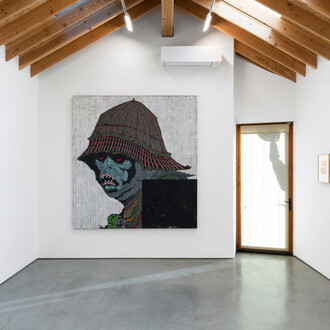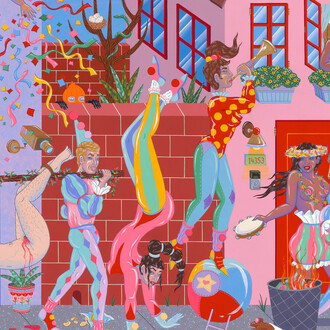Simchowitz is pleased to present After Image by Brian Harte (b. 1978), who currently lives in Kinsale, Ireland, with his wife and two small children. The title is based on the optical phenomena of seeing images long after they’re gone, which is fitting for an artist who claims to explore “time travel” in his work, where hints of the past, present and future seem to coexist at once.
Most of Harte’s medium-to-large format paintings, generally painted with oil on linen, begin with large, flattened fields, often painted with a single color. Yet they’re also littered with the flotsam and jetsam of daily life: pieces of furniture, random toys left behind, sweaters, crumpled beds, stains on the wall, pieces of food, various animals, etc. And while such domestic scenarios unfold with a concise economy of color and the immediacy of gesture, they also contain unexplainable elements such as dismembered legs or hands, Egyptian heads, and/or tables floating in the sky. Harte claims that one of his early influences was Japanese art, “Especially in the way that they’re not read through perspective,” he says. “I like dropping things down from the top or side, so the logic really falls apart. As soon as you think there’s a narrative there, it’s gone. But I’m looking for that. I want them to be on the edge of failure all the time.”
In truth, the dynamics operating within these topsy-turvy spaces are produced through a restless intuition and an unwavering dedication to all those tiny moments that pass us by each day: a quick gesture that his son makes, his wife relaxing in a chair, a wave, a jump, a fall, or even something someone once said. These are layered in a way that suggests that this is Harte’s reality, acutely felt and carefully conveyed, seen all together all at once. It’s a suggestion that thoughts, memories, feelings, and external contingencies of every kind can never truly be left behind. They may be forgotten, but nevertheless, always there, always present.
A good example is Warriors Both of Course 2020, a large painting that depicts a brownish room with a life-sized drawing on the wall. It’s a complex piece, featuring a virtual tornado of activities in the foreground. These activities, explains Harte, are memories of himself with one of his childhood friends, which was full of play, banter, and competition. “This is a common theme,” he says about his work, “dealing with childhood memories and moments, but within adult structures.”
Harte suggests that his work might be “steeped in Modernism,” but what is perhaps more interesting is the way in which it can also be seen as a deft hybrid of Modernism’s emphasis on the grid and today’s emphasis on the cloud. “I want them to look more like a network of things,” he explains. “Disjointed maybe, but a network of things, because that is how we exist at the moment.”
Harte admits to a long-standing interest in British art, in particular the work of Frank Auerbach and David Bomberg. But he also confesses to enjoying Irish mythology and lore—the same narratives that shaped other Irish artists such as Samuel Beckett, James Joyce and Francis Bacon—all of whom he respects and admires. Like them, it’s quite easy to see the theme of claustrophobia at play in his work, even if it’s subconscious (something to do with living on an island). Yet for most viewers, it’s how he renders his figures—disfigured, morphed and blended, and often within the confines of a container of sorts—that inspires many to think of Bacon first and foremost, even though in truth, the similarities are minor. Nevertheless, Harte admits to digging into uncomfortable territories once in a while, like his piece Untitled 2020, which depicts a domestic setting submerged under water. “There might be a few monsters in there,” he adds with a grin. “I’m not so sure about that one. It scares me a little.”
Brian Harte (b. 1978, County Tipperary, Ireland) graduated from the Crawford College of Art, Cork in 2002. Recent exhibitions include solo shows at Art Antwerp with Tatjana Peters Gallery Ghent, Belgium (2022), MAKI Gallery, Tokyo (2023, 2021), Annarumma Gallery, Napoli Italy (2021), GNYP Gallery, Berlin, Germany, (2020, 2019, 2017), These Days Gallery, Los Angeles, USA (2020) and Ever Gold [Projects], San Francisco, USA (2018). His work is held in both public and private collections, notably, Kunstmuseum Wolfsburg, Germany and The Crawford Municipal Gallery, Cork, Ireland. More recently, it has been acquired by the Arts Council of Ireland, and the Oketa Collection Japan.
















